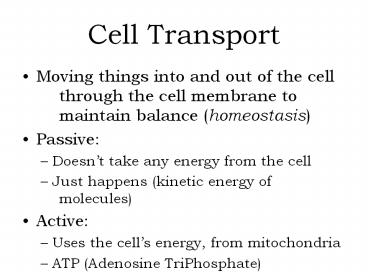Cell Transport - PowerPoint PPT Presentation
1 / 20
Title:
Cell Transport
Description:
Cell Transport Moving things into and out of the cell through the cell membrane to maintain balance (homeostasis) Passive: Doesn t take any energy from the cell – PowerPoint PPT presentation
Number of Views:74
Avg rating:3.0/5.0
Title: Cell Transport
1
Cell Transport
- Moving things into and out of the cell through
the cell membrane to maintain balance
(homeostasis) - Passive
- Doesnt take any energy from the cell
- Just happens (kinetic energy of molecules)
- Active
- Uses the cells energy, from mitochondria
- ATP (Adenosine TriPhosphate)
2
Cell Memebrane
- Phospholipid Bilayer
- 2 layers, back to back, of molecules of fat
called phospholipids - Fluid Mosaic
- Other molecules, too, like proteins, but they
dont just sit there, they move around - Selectively permeable
- Not just anything can pass through
3
Cell membrane
4
Diffusion
- Molecules simply move from an area of higher
concentration to lower (with concentration
gradient) - Because of the molecules kinetic energy
(passive) - Will stop when reach equilibrium (equal
concentration) - Molecules still move, but for each one that
moves in to the cell, one moves out (no net
movement)
5
Diffusion across cell membrane
- Happens only for very small particles (salt,
etc.) - Move between phospholipid molecules of the
bilayer - Or for molecules that are nonpolar
(hydrophobic) and dissolve into the space
between the two layers of the cell membrane, but
not in water
6
Facilitated diffusion
- For molecules that are too big to get in (e.g.
sugar), or have charges (ions) - Proteins in the cell membrane will chemically
bind to the molecule. (specificonly 1 molecule
per proteinlike a lock and key) - The protein will then change shape and the
molecule will move in or out of the cell. - Takes no energy (passive)
7
Facilitated diffusion
- Note each protein is specific for one molecule,
but there are many different proteins in each
cell membrane
8
Osmosis
- Special kind of diffusion (passive)
- Only for water across the membrane
- Water can move against its concentration
gradient, that is water can move from low water
to high water concentration - Water moves to water down whatever is most
concentrated.
9
Osmosis
- If the cell has more stuff dissolved outside
than inside, it is in a hypertonic environment - It will try to water down the environment to
make it less harsh - Water leaves the cell, the cell shrinks
(plasmolysis) - http//www.youtube.com/watch?vgWkcFU-hHUkfeature
related
10
Osmosis
- If the cell has more stuff dissolved inside
than outside, it is in a hypotonic environment - It will try to water down the inside to make
it less harsh - Water enters the cell, the cell grows
- If it gets too big, it explodes (cytolysis)
- http//vimeo.com/2726364
11
Osmosis
- If the cell has equal amounts of stuff
dissolved inside and out, it is in an isotonic
environment - Water molecules will move both in and out of the
cell equally, so there is no net movement of
water - Notes water still moves in and out in
hypertonic and hypotonic solutions, but the net
movement is in one direction
12
Equilibrium
- Passive transport will continue until equal
concentrations are reached in and out of the
cell (equilibrium). - Molecules still move back and forth across the
membrane, but do so at equal rates - No net (total) movement of molecules, though
13
Active Transport
- Sometimes cell wants higher or lower
concentrations (not equilibrium) - Have to use the cells energy (ATP adenosine
triphosphate) - Moves against concentration, i.e. from low to
high concentration - Moves large molecules or large amounts of
molecules
14
Protein Pumps
- Energy changes shape of the protein to move
things in/out of the cell - Is specificeach protein can only chemically
bind with one molecule, but there are many
different proteins in the cell membrane (like a
lock and key) - Na K pump
15
Protein pumps
- 3 sodiums are taken out of the cell and 2
potassiums brought in using ATP.
16
Transport by vesicle
- Moves large molecules or large quantities of
something into and out of the cell - Into the cell is called endocytosis
- Pinocytosis water/liquid moves
- Phagocytosis solids move
- Out of the cell is called exocytosis (e.g.
products from Golgi Apparatus)
17
Endocytosis
- Note part of cell membrane makes the vesicle and
is now inside the cell! - http//www.youtube.com/watch?vW6rnhiMxtKU
18
Exocytosis
- Note the vesicle fuses with the cell membrane
and is now part of it! - http//www.youtube.com/watch?vU9pvm_4-bHg
19
(No Transcript)
20
ATP
- Adenosine Triphosphate
- ATP
- Adenosine Diphosphate
- ADP P energy































